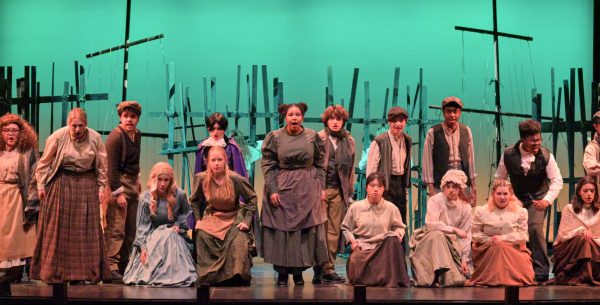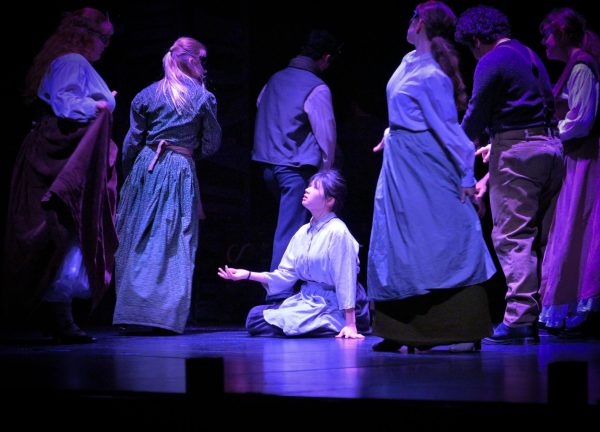An eerie tone overtook the Donna Hubbard Auditorium in spring as the VNHS Theatre Company presented “Sweeney Todd: The Demon Barber of Fleet Street” on March 14, 15, 16 and 17.
In Stephen Sondheim’s Sweeney Todd, the evil Judge Turpin lusts for the beautiful wife of a London barber and transports him to Australia for a crime he did not commit. Returning after 15 years and calling himself Sweeney Todd, the now-mad man vows revenge, applying his razor to unlucky customers and shuttling the bodies down to Mrs. Lovett, who uses them in her meat pie shop. Though many fall to his blade, he remains unsatisfied until he ultimately slits Turpin’s throat.
With casting happening before Thanksgiving break, the cast and crew worked nonstop to put on the show. While the rehearsal process was just under ten weeks long, for cast members like freshman Amelia Probst who played Beadle Bamford, everything went by in the blink of an eye.
“I feel like this process just went by so fast,” she said. “I’m not sure if it was because I was so familiar with the show beforehand, or if it’s just such a busy show so we were always working.”
Beginning in November, over 50 students auditioned for the show. With a cast size of only 20, all auditioners entered the audition ready to work.
Junior Emily Chavez, who played the leading role of Mrs. Lovett, entered the rehearsal room more than prepared.
“I studied and studied before the audition,” she said. “I listened to the soundtrack a million times and watched clips and videos, and even then, I still felt unprepared.”
Chavez badly wanted to be a part of the show.
“Sweeney is one of my favorite shows,” she said. “It’s an impressive show, especially for high schoolers. When we were told we were doing it, I was surprised, but the challenging nature of it is what drew me to it.”

Playing the role of Anthony, freshman Tucker Chandler entered the rehearsal room as an outsider. A student at the Los Angeles Charter High School of the Arts, more commonly known as LACHSA, last semester, Chandler explained that while he was nervous being the new kid, being a part of the show wasn’t intimidating.
“Everyone that I was auditioning alongside with was so nice,” he said. “The room was really cold, so I couldn’t really breathe, but it just felt right. Especially compared to other places I’ve been.”
Once casting was finalized, theatre teacher and production director Justin Baldridge wasted no time before starting rehearsals.
“After our first read-through and first rehearsal I became excited with the group of people we’d put together to put on this production,” he said. “The excitement from every individual hopefully permeated to the rest of the campus.”
Baldridge took a risk when directing this show. Rather than have the classic two-storied set and elaborate stage blood, he took a minimalistic approach, striving for originality over conformity.
But the production might have looked very different if school budget cuts didn’t get in the way.
Junior ensemble member April Cho says that while the budget was a deciding factor for the concept of the show, the lack of funding made the show unique, and in turn, piqued more people’s interest.
“While the budget was a deciding factor, our Sweeney is supposed to be simple, so it is,” she said.
While the actors worked hard on stage during rehearsals, the crew worked just as hard behind the scenes, making sets, costumes and dozens of pies.
Junior Kayla Balikyan-Davis, who served as one of the Assistant Stage Managers for this production, explains that while the actors have Baldridge to guide them, a lot of the Technical Theatre program is student-run.
“Mr. B is very focused on the cast, so we learn to do everything ourselves,” she said. “We have older students train younger students, and most of us take a technical theatre class, but tech is really about working with other people and growing from there.”
She claims that without technicians, the show simply wouldn’t exist.
“By the time the performance comes around, we have run the show so many times and it’s so embedded in our brains that it’s just muscle memory,” Balikyan-Davis said. “We still have problems backstage, but we all work together to fix anything as quickly and smoothly as possible.”
While working the tech-end is a lot of work, Balikyan-Davis wouldn’t trade it for anything.
“So much planning goes into something like this,” she said. “We work and work, and spend so much time outside of school working. It’s what makes tech so special.”

As the cast continued rehearsals, opening night came closer and closer.
One week before the show, Tech Week is the time when lighting, sound, costumes, props and set all come together.
Senior Max Sandoval, head of prop and set design, explains that while stressful, Tech Week serves as the culmination of weeks of hard work.
“Tech is so stressful in a way,” they said. “We’ve all been working separately for weeks, and Tech Week is the time where we all come together and just pray we did everything right.”
This year for the production, the cast and crew dedicated over 40 hours to rehearsal after school in a single week, ensuring a seamless production.
Junior Pamela Fajardo-Alfaro, a sound board operator, states that when Tech Week comes around, everything in the cast and crew’s personal lives comes to a halt.
“Tech week is like working a full-time job,” she said. “We don’t get home until close to nine, so we eat, take a shower and are drained. We don’t even have time to think about homework. We love to be here and we love the people, but it’s exhausting.”
In addition to the hours spent on campus in rehearsals, the cast spends hours at home preparing. For junior Julian Pankowski, who played the titular Sweeney Todd, this process can take hours.
“It took me a lot longer than I thought to get off the book, so by the time it was time for the run-through, I spent over five hours learning lines and songs,” he said. “I got it done, but it was stressful.”
Leads like senior Maddie K.C. Jorden, who played Johanna, spent so much time rehearsing at home, their role became second nature.
“I feel like just grinding your songs, every second available, becomes your life,” she said. “I hate hearing myself singing, but when I’m at home I’ll blast the fan, turn on the shower and just start going crazy on a specific part of the music.”
Hours were dedicated, not only because hours of rehearsal make a great show, but because this particular show is so challenging.
“Stephen Sondheim was such a genius, but the music is so tough, especially when you can’t read music,” Junior Alexis Martinez said. “The problem is, you can be a single count off, and then be off for the rest of the song. So we spend time learning, listening and using a metronome because everything is just so specific.”
Chavez agrees.
“This show is so music heavy,” she said. “You have to be working all the music on your own, or the show is gonna be a hot mess.”
For the cast, elevating their acting skills for the musical was its own feat.
“Mr. Baldridge always talks about how everything is life or death on stage,” K.C. Jordan said. “I worked on getting everything I said or did up to a much higher level.”

The production forced the actors to become creative with their rehearsal methods.
“I have a garage that we turned into a guest house,” Probst said. “I would go out there on weekends and practice and practice to get everything down before coming into rehearsal.”
During the final performances, the cast and crew saw audience numbers beyond what they ever could have imagined, with over 500 people attending the first two shows.
Sophomore Dilan Patton, who played Judge Turpin, explains that Sweeney Todd attracted such large numbers because the show was so popular in mainstream media and so different from a typical school production.
“It’s dark, it’s creepy and like 12 people get killed back to back,” Patton said. “We can tell when people are bored in an audience, and you just can’t be bored with this show. There are so many things going on constantly. There is always something to watch, something keeping you on the edge of your seat.”
Junior ensemble member Sophia Hillstead says that the cast really brought the show to life and kept the audience engaged.
“We work together as an ensemble to find characters and stories,” they said. “Even if no one knows what we create, we know as a cast, and it elevates the show.”’
While this year’s spring musical brought in thousands of dollars for the VNHS Theatre Company, students and staff are still fighting hard for a budget increase to continue funding programs like this.
“I think we would have more opportunities if we had a larger budget,” junior ensemble member Addi Cudd said. “If there was a better understanding at this school, and in LAUSD in general of the arts, then we would have a better chance of success. Students shouldn’t be forced to do less, or have less experience, because LAUSD doesn’t understand why we need it.”



